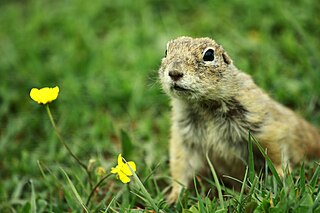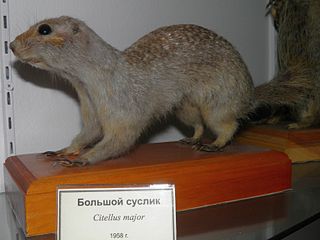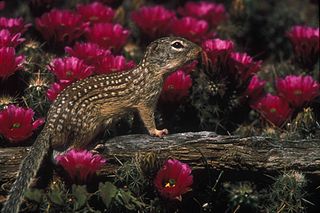
The California ground squirrel, also known as the Beechey ground squirrel, is a common and easily observed ground squirrel of the western United States and the Baja California Peninsula; it is common in Oregon and California and its range has relatively recently extended into Washington and northwestern Nevada. Formerly placed in Spermophilus, as Spermophilus beecheyi, it was reclassified in Otospermophilus in 2009, as it became clear that Spermophilus as previously defined was not a natural (monophyletic) group. A full species account was published for this species in 2016.

Franklin's ground squirrel is a species of squirrel native to North America, and the only member of the genus Poliocitellus. Due to the destruction of prairie, the populations of Franklin's ground squirrel have dwindled, approaching levels of concern. Its decline in the eastern portion of its range is mostly attributed to habitat fragmentation.

The northern Idaho ground squirrel is a species of the largest genus of ground squirrels. This species and the Southern Idaho ground squirrel were previously considered conspecific, together called the Idaho ground squirrel.

Spermophilus is a genus of ground squirrels in the squirrel family. As traditionally defined the genus was very species-rich, ranging through Europe, Asia and North America, but this arrangement was found to be paraphyletic to the certainly distinct prairie dogs, marmots, and antelope squirrels. As a consequence, all the former Spermophilus species of North America have been moved to other genera, leaving the European and Asian species as true Spermophilus.

The European ground squirrel, also known as the European souslik, is a species from the squirrel family, Sciuridae. It is among the few European species in the genus Spermophilus. Like all squirrels, it is a member of the rodent order. It is to be found in eastern and central Europe from southern Ukraine, to Asia Minor, Austria, the Czech Republic, Slovakia, Serbia, Greece, Romania, Bulgaria, North Macedonia and north as far as Poland but the range is divided in two parts by the Carpathian Mountains.

The Arctic ground squirrel is a species of ground squirrel native to the Arctic and Subarctic of North America and Asia. People in Alaska, particularly around the Aleutians, refer to them as "parka" squirrels, most likely because their pelt is good for the ruff on parkas and for clothing.

Belding's ground squirrel, also called pot gut, sage rat or picket-pin, is a squirrel that lives on mountains in the western United States. In California, it often is found at 6,500 to 11,800 feet (2,000–3,600 m) in meadows between Lake Tahoe and Kings Canyon. This species is not of conservation concern, and its range includes some protected areas.

The Cape ground squirrel or South African ground squirrel is found in most of the drier parts of southern Africa from South Africa, through to Botswana, and into Namibia, including Etosha National Park.

The Uinta ground squirrel, commonly called a "chisler" and Potgut in northern Utah, is a species of rodent native to the western United States.

The gray marmot, grey marmot, or Altai marmot is a species of rodent in the squirrel family Sciuridae. It is one of the larger marmots in the genus Marmota. It occurs in mountainous grasslands and shrub lands of central Asia, and is one of the 9 Palearctic (Eurasia) species. It is found in Xinjiang Province in China, southeastern Kazakhstan, Kyrgyzstan, Mongolia, and in the Altai and Tien Shan Mountains in southeastern Siberia in Russia. In the Mongolian Altai, its range overlaps with that of the Tarbagan marmot. Gray marmots form social groups, live in burrows, and hibernate.

Merriam's ground squirrel is a species of rodent in the family Sciuridae. It occurs in the western United States in Idaho, Nevada, and Oregon.

The red-cheeked ground squirrel is a species of rodent in the family Sciuridae. It is commonly referred to as the red-cheeked ground souslik and there are several recognized subspecies. It is found in central Asia. Spermophilus brunnescens, Spermophilus heptneri and Spermophilus ungae are accepted as synonyms. There is some controversy over whether Spermophilus pallidicauda and Spermophilus brevicauda should be regarded as synonyms or full species.

The russet ground squirrel is a species of rodent in the family Sciuridae. It is also known as the hibernating large ground squirrel and the large-toothed souslik. It is found in west central Asia where its natural habitat is temperate grassland.

The Mexican ground squirrel is a species of rodent in the family Sciuridae. It is found in Mexico and the United States. One of its closest relatives is the thirteen-lined ground squirrel.

The little ground squirrel or little souslik, is a species of rodent in the family Sciuridae. It is found from Eastern Europe to Central Asia.

The spotted ground squirrel is a species of ground squirrel in the rodent family Sciuridae. It is found throughout Mexico and the central and western United States. Characterized by a white spotted back, the spotted ground squirrel is one of the smallest squirrels found in North America. They are mainly herbivorous, but also eat insects. A burrowing mammal, the spotted ground squirrel will make tunnels to store its food, as well as shelter and hibernation quarters.

The speckled ground squirrel or spotted souslik is a species of rodent in the family Sciuridae from Eastern Europe. Spermophilus suslicus consists of three subspecies: S. s. boristhenicus, S. s. guttatus, and S. s. suslicus. It is threatened by habitat loss.
The Tian Shan ground squirrel is a species of squirrel found in the grasslands of western China, Kazakhstan, and Kyrgyzstan. A close relative of Spermophilus relictus, it was formerly considered the same species. It was formerly known as Spermophilus ralli, but that name is now known to be a synonym of S. relictus.
Spermophilus brevicauda is a species of rodent in the family Sciuridae. It is found in eastern Kazakhstan and the northern half of the Xinjiang region of China.

The Japanese dwarf flying squirrel is one of two species of Old World flying squirrels in the genus Pteromys. During the day this squirrel hides in a hole, usually in a coniferous tree, emerging at night to feed.



















